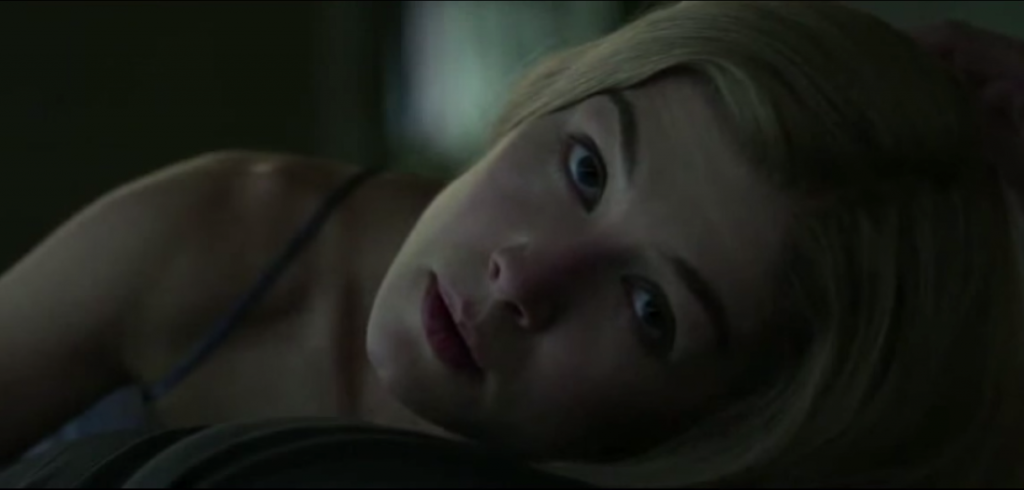
Gone Girl
Trent Reznor & Atticus Ross
Columbia
Back in 2010, David Fincher reaching out to the frontman from Nine Inch Nails felt like a 90s reunion, a fan casting list straight out of BuzzFeed’s nostalgia machine. In hindsight, Trent Reznor and longtime collaborator Atticus Ross’s score for The Social Network was something far more dour than “The Facebook Movie,” and the two of them have golden statues to show for it. Now, the pairing seems like an inevitable collaboration between a director who found his start in music videos and two of the most influential voices in music over the last quarter-century. Toss in table scraps from Fincher’s CGI-consumed Panic Room in a 2005 video for “Only,” and yeah, crazier things have happened.
Fast forward four years, critical acclaim, more than a dozen awards nominations, and a follow-up in The Girl With the Dragon Tattoo, and Reznor and Ross have shown a ghostly, garbled compositional style influenced by the spaciness of Nine Inch Nails’ The Fragile. The Social Network is covered in the track marks of “The Wretched’s” molten bubbles and “The Big Come Down’s” shivers, while Hughes brothers enthusiasts will find more of Ross’s blase The Book of Eli chill in The Girl With the Dragon Tattoo. With Fincher’s Gone Girl, Reznor and Ross return to the director, this time with a full orchestra — and The Social Network 2 it is not.
It’s also not Zodiac. In adapting her own novel, Gillian Flynn flatters her beach read’s ideas by downplaying what reads like a pulpy detective story’s cliffhanger chapters. Instead, the film fades between Nick Dunne’s (Ben Affleck) day-and-night searches for eponymous missing wife Amy (a breathy Rosamund Pike) and narrated sequences voiced by Amy herself. These past-present-past switches boost Flynn’s story with a blanching effect, moving from a tense mystery to icy reflection. Reznor and Ross keep things chilled. “What Have We Done to Each Other?” plays under Nick’s opening daydreams as he indulges in the impenetrable mysteries of Amy. Cold and vaporous, the cue’s longing trumpet elevate it above ethereal fluff as synths mimic distant boat horns. This feels like a sly float down a winding river toward some watery, unseen fate. Perhaps I’ve said too much.
“Sugar Storm” possesses an undeniable Nobuo Uematsu quality in its tufts of upward bells (if you were looking for more 90s nostalgia, Final Fantasy VII references make three.) The cue plays under a memory, specifically the film’s first: Nick and Amy’s first meeting at a party, with screeches and a sonar-like ping staining an otherwise charming meet-cute. Those same bells become more deliberate and more urgent in “Empty Places,” though a detachment remains thanks to some grungy strings. Fincher and Flynn have found a kinship in their cynical approaches to romance, and any gestures toward heartwarming romance here are hollow and whited out.
“Sugar Storm” and “Empty Places” are two of three separate cues Reznor and Ross reprise, morphing repetition and variation into ghostly reappearances. Regardless of whether you consider Gone Girl a metaphorical ghost story, a post-feminist screed or a marriage allegory, the clues Amy Dunne leaves behind for Nick’s anniversary gift lend Flynn’s story a creepy tension. Again, the music is right there. “Clue One” picks up “Sugar Storm’s” bells with a steady and deliberate pace while “Clue Two” throws the well-established tension into a tizzy with oscillations and laser zaps, pulling along a paranoid route with low synth and stutters. “Procedural’s” heart-thumping immediacy might play under a lesser film’s climactic bank heist, but Reznor and Ross turn synth and poking downbeats into the cue’s least interesting elements as faint drones and scratches come to the fore.
Gone Girl’s eeriest moments are indebted to its score, and long stretches of Nick’s search don’t feel frantic so much as guided by Flynn’s Midwestern claustrophobia. Playing under Nick’s discovery of a devastating anniversary limerick, “The Way He Looks At Me” aggravates and accelerates Gone Girl’s key plot twist with sharp tuba bursts over a squeaking underbelly. The cue is busy – chaotic even, as wheezes and distorted coughs steady its pace — but never to the point that the jumbled textures don’t feel headed in the same direction. In actuality, it’s all foreplay to “Technically, Missing” and “Consummation” which, apart from ushering in some serious plot developments, unearth deep-seated character traits through gradual crescendos. The former revs its engine under a “pull back the curtain” montage that, with a particular voiceover, plays like a kind of demented Martha Stewart how-to. “Consummation” on the other hand implodes under the weight of sputtering metallic bursts. If the brass staccato in “The Way He Looks At Me” were pokes, these would surely bruise.
In describing his and Ross’s approach, Trent Reznor talks about Gone Girl’s sound as “artificially insincere.” It’s not a stretch to see why. There’s a tendency to lull the listener into a hypnosis before slipping them the poison. Even piano-driven moments in “Just Like You” and “Background Noise,” the score’s most organic cues, are tainted by their synthetic elements. It’s an assault, but a slow, ubiquitous one. Nick and Amy are repeatedly bludgeoned, literally and figuratively, by internal and external pressures. “They told us and told us and told us,” Amy writes in her diary, “marriage is hard work.” Physical abuse draws blood, but it’s the passive-aggression and the half-hearted sex that Reznor and Ross key in on.
If Gillian Flynn’s prime argument is that these little pushes add up, the score has shucked this idea raw, pecking away at wedding anniversary after wedding anniversary until all that remains is a cold shell. Reznor and Ross follow Fincher’s lead and invert the order of their cues to match Gone Girl’s epilogue, which mirrors Nick’s first hazy, disturbed daydream. Outwardly, Gone Girl closes in much the same way it opens. The fear comes in finding what’s changed and what was always there to begin with.

